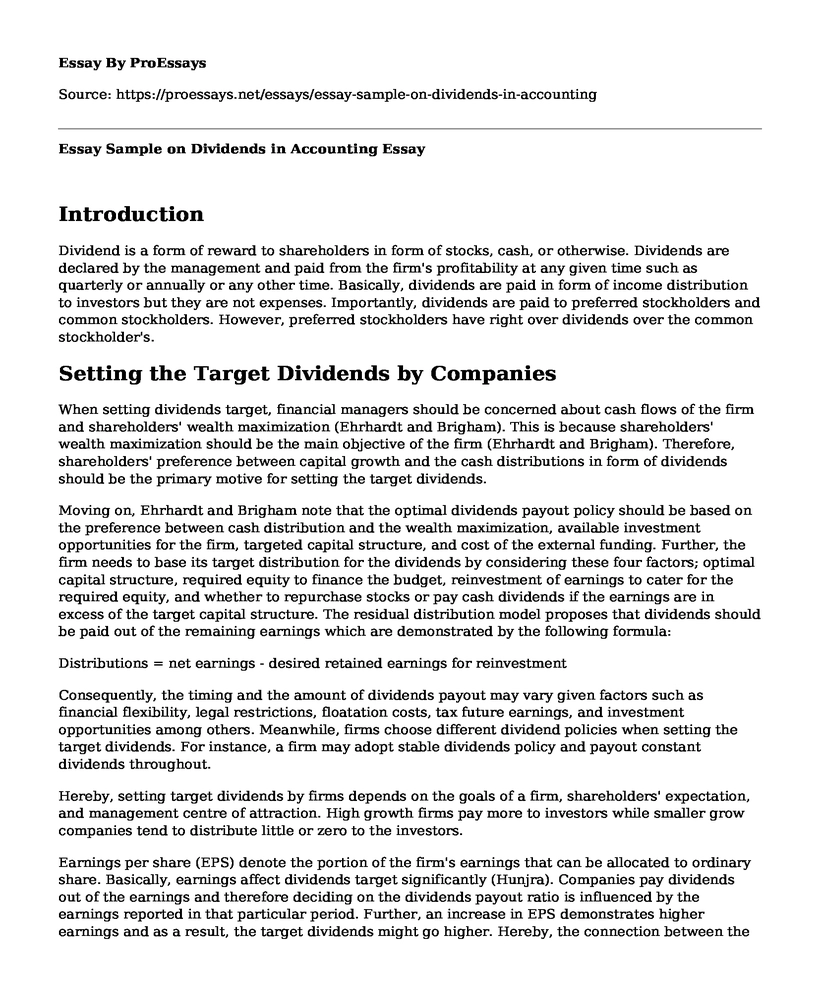Introduction
Dividend is a form of reward to shareholders in form of stocks, cash, or otherwise. Dividends are declared by the management and paid from the firm's profitability at any given time such as quarterly or annually or any other time. Basically, dividends are paid in form of income distribution to investors but they are not expenses. Importantly, dividends are paid to preferred stockholders and common stockholders. However, preferred stockholders have right over dividends over the common stockholder's.
Setting the Target Dividends by Companies
When setting dividends target, financial managers should be concerned about cash flows of the firm and shareholders' wealth maximization (Ehrhardt and Brigham). This is because shareholders' wealth maximization should be the main objective of the firm (Ehrhardt and Brigham). Therefore, shareholders' preference between capital growth and the cash distributions in form of dividends should be the primary motive for setting the target dividends.
Moving on, Ehrhardt and Brigham note that the optimal dividends payout policy should be based on the preference between cash distribution and the wealth maximization, available investment opportunities for the firm, targeted capital structure, and cost of the external funding. Further, the firm needs to base its target distribution for the dividends by considering these four factors; optimal capital structure, required equity to finance the budget, reinvestment of earnings to cater for the required equity, and whether to repurchase stocks or pay cash dividends if the earnings are in excess of the target capital structure. The residual distribution model proposes that dividends should be paid out of the remaining earnings which are demonstrated by the following formula:
Distributions = net earnings - desired retained earnings for reinvestment
Consequently, the timing and the amount of dividends payout may vary given factors such as financial flexibility, legal restrictions, floatation costs, tax future earnings, and investment opportunities among others. Meanwhile, firms choose different dividend policies when setting the target dividends. For instance, a firm may adopt stable dividends policy and payout constant dividends throughout.
Hereby, setting target dividends by firms depends on the goals of a firm, shareholders' expectation, and management centre of attraction. High growth firms pay more to investors while smaller grow companies tend to distribute little or zero to the investors.
Earnings per share (EPS) denote the portion of the firm's earnings that can be allocated to ordinary share. Basically, earnings affect dividends target significantly (Hunjra). Companies pay dividends out of the earnings and therefore deciding on the dividends payout ratio is influenced by the earnings reported in that particular period. Further, an increase in EPS demonstrates higher earnings and as a result, the target dividends might go higher. Hereby, the connection between the target dividends and EPS is that EPS hugely dictates the amount of earnings to be distributed to investors as dividends.
Do Non-GAAP Metrics Rationalize Dividend Policy?
GAAP provides the foundation for the preparation of the financial statements for both private and public firms. However, some companies prepare their financial statements outside the GAAP guidelines commonly regarded as Non-GAAP measures. However, this non-GAAP should be shown by the management if it decides to go outside the GAAP framework.
Among the metrics that are explained by non-GAAP measures, dividend payout is one of them. As a non-GAAP measure, payout ratio helps the management in developing a comprehensive dividend policy for the company. According to the US Securities Exchange Commission Financial Reporting Manual on non-GAAP measures, determination of the dividends is highlighted under the dividend requirements section. Therefore, non-GAAP metrics rationalize the discretion the management has in deciding dividend policy to adopt and implement.
Work Cited
"SEC.Gov | Financial Reporting Manual". Sec.Gov, 2018, https://www.sec.gov/corpfin/cf-manual/topic-8. Accessed 30 Nov 2018.
Ehrhardt, Michael C., and Eugene F. Brigham. Corporate finance: A focused approach. Cengage learning, 2016
Hunjra, Ahmed Imran, et al. "Impact of Dividend Policy, Earning per Share, Return on Equity, Profit after Tax on Stock Prices." (2014): 109-115.
Cite this page
Essay Sample on Dividends in Accounting. (2022, Oct 29). Retrieved from https://proessays.net/essays/essay-sample-on-dividends-in-accounting
If you are the original author of this essay and no longer wish to have it published on the ProEssays website, please click below to request its removal:
- Foreign Direct Investment in Saudi Arabia Paper Example
- Paper Example on XYZ Inc. to Raise Money: Bonds vs. Stocks
- Greece's Debt Crisis: A Historic Rescue From Bankruptcy - Research Paper
- The US Debt Crisis: A History of Borrowing and Lending - Essay Sample
- Essay Example on Estate Planning: Bequeathing Assets & Settling Taxes
- Essay Example on Six Factors That Differentiate Financial Management in Multi-Country Companies
- Target Breach: 70M Records Stolen, 2nd Largest Retail Breach Ever







